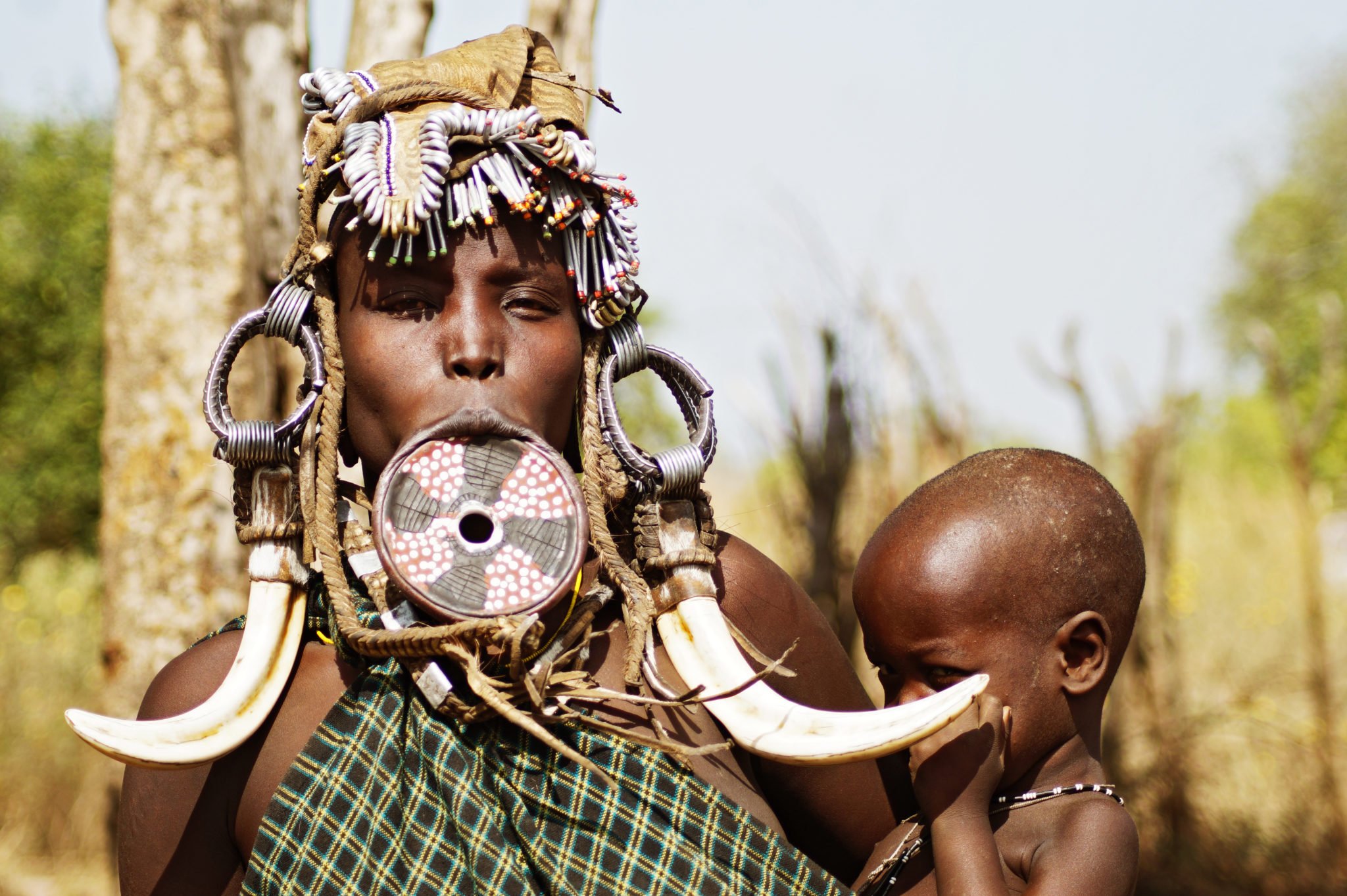The Mursi tribe is a Surmic ethnic group in Ethiopia. They are most famous for the lip plates female members of the tribe wear. The tribe resides in the area close to the border with South Sudan. Per the census in 2007, there are 11,500 members of the Mursi tribe. Only 848 of them live in urban areas, while the rest of them live in the Southern Nations, Nationalities, and People’s Region.
Their home is one of the most isolated regions in Ethiopia. Some of them adopted Christianity, but most Mursi people follow Animism.
Why the Lip Plate?
As we said before, the lip plate is their most prominent feature. Their clothes are rich and colorful. Where does the lip plate tradition come from? Well, there is no defining reason. There is no clear answer to this. Some theories suggest the lip plate tradition comes from the age when slavery was the norm in Africa. Women placed plates so they look unattractive to hunters.
Another popular theory is that evil spirits enter the body through the mouth. So, with the lip plates, they defend themselves against evil spirits.
The more traditional theory is linked to marriage. Usually, when women reach puberty, between 15 and 16 years, she will have her lip cut by a female member of the tribe. Then, a small wooden stick is inserted. This stretches the lip over a period of time, first by inserting larger sticks each night and then eventually wearing plates of various sizes and decorations.
Women who do not wear lip plates are considered lazy and will not warrant as large a bride wealth. The lip plates can be made from wood or clay. They are worn by single or newly married women at four main occasions. They include serving food to men, special events like weddings, during donga dueling and competitions, and at dances.
After a couple of years in marriage, the woman can slowly stop wearing her lip plate. And if her husband passes away, she can remove it altogether.
Everyday Life
Men take up arms as warriors. They protect the village. Women, on the other hand, do the most important work, and that includes constructing homes and looking after the children. Women also have to prepare food and transport water to the village.
Their common meal is dry cereal made from maize and sorghum. They add milk and blood cut from a cow’s neck to it. But they do not kill the cow.
They have to move every 9 to 18 months to look for greener pastures for their cattle. Once they find a suitable area, they build villages from mud huts covered in dry grass. Men run the community. They come together and make collective decisions.
![]()
As for their religion, the Mursi follow animism. They believe in Tumwi, a God, and the villages’ komoru, a Priest. The people believe their Priest will lead public ritual to gain the God’s blessings over the people, harvest, and cattle.
Since Christian missionaries started arriving in the area, some people have adopted Christianity. The goal of these missions was to convert the indigenous people.
Relationship with tourists
The Mursi people have an intimidating reputation. They are known as fierce an aggressive, both with neighboring tribes and tourists. But despite all of that, many tourists still chose to visit Mursi villages. It is a popular activity for travelers in the Omo Valley.
Tourists describe it as an incredible opportunity to learn more about the tribe that shines outside technology. The Mursi people have proud and rich culture. Some tourists try to pay for photo, but that approach can create an uncomfortable and aggressive atmosphere.
But just as we are curious about the tribe, the members are also curious for our way of life. You can see that in men, women, and children in the village.
Travelers have to pay for the privilege of visiting a village. But once you leave the village, you take with you the distinctive appearance, unique lifestyle, and intriguing culture of the tribe.
Some Quick Facts You Need to Know
- Mursi people are predominantly a pastoral and nomadic tribe, and they measure their wealth in cattle
- Because of the amount of cattle they own, the Mursi tribe is one of the richest in the Omo Valley
- Men carry a stick, called donga with them. But since they have increased their wealth, some of them now carry an AK-47 riffle
- Scarification is a common ritual, with design of small dots on the left shoulder of men announcing their passing into adulthood
- There are four types of marriage in the tribe, arranged, consensual, via force or kidnap, and by inheritance. The last one means a widow gets passed to the oldest brother or closest male relative of her deceased husband
- Men name themselves after the color of their favorite cattle
- Women name themselves after the patterns on their favorite wild animal
- Men wear a blanket tied over one shoulder, while women wear a goatskin dress or skirt
- Men cannot marry until they win a donga (stick fight). It is a ritual to prove their strength to girls and find a wife
- Women are instantly recognizable by the clay plates they wear in their ears and lips
- Some cattle get decorated as prized cows, with their horns turned inwards and their skin scarred with special design
- Their diet includes dry porridge made from sorghum or maize, usually with milk and blood from cows



